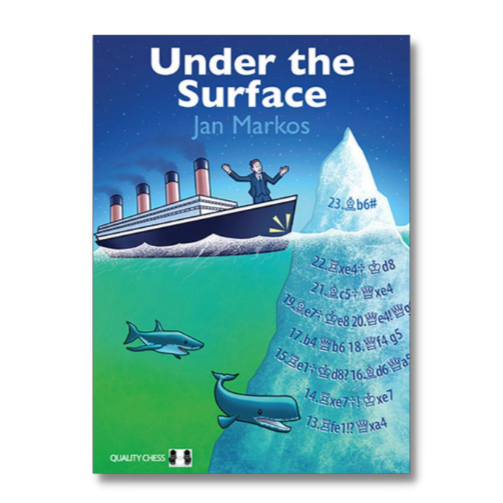Book review of The Secret Ingredient
“In short, this book wants to teach you how to win at chess.”
– The author, Jan Markos.
The Secret Ingredient complements Under the Surface, the highly successful book by GM Jan Markos. For the current book, Markos has been joined by his friend GM David Navara, who adds some interesting perspective to the book as a very strong GM. Most of the book is written by Markos, while Navara’s contributions are in a different font to clearly distinguish them.


Markos compares the two books as follows.
“A couple of years ago, I wrote the book Under the Surface. Here my goal was to show the beauty and depth of the chess game; the strength of chess thinking. I guess I was quite successful – the book won the Book of the Year award from the English Chess Federation in 2018.
The book you’re holding now is much less idealistic. And much more practical. Profound thoughts about chess are fine if you’re sitting at home in your armchair. At tournaments, however, what matters is winning.”
Markos writes that the motivation for the book was a key game that he lost in the World Youth Chess Championship when he was fourteen.
“Looking back now, I’m not surprised that I lost. I might have been a gifted chess player back then, but I was not aware of the secret ingredient needed to succeed in chess: I knew almost nothing about practical aspects of a chess fight. I had no idea how to prepare for an opponent or how to control my emotions. And I knew absolutely nothing about how a crucial game should be played.
This is above all a practical book. My goal is simple: I want to help you avoid as many disastrous defeats…as possible. I’ll show you what a real fight on the chessboard is all about. And I would like you to learn how to hold your ground in this fight. I’ll tell you how to cope with stress, how to use our time efficiently and how to make well-reasoned decisions. I’ll show you how to prepare for every individual opponent and how to play endgames in 30-second rhythm. In short, this book wants to teach you how to win at chess.
The book is divided into ten chapters that cover an extensive range of topics that are essential for success in chess games. The topics include the day-to-day practice of chess grandmasters, including calculation skills, computer-assisted analysis, defense, time trouble, draw offers, chess psychology, and preparing for opponents, including appropriate opening choices. The book concludes with a chapter with ten exercises and a final review chapter.
The chapter on preparing for specific opponents uses three players of varying strengths, including former world champion Anatoly Karpov, as hypothetical role models for tackling this important aspect of practical chess.
Markos writes about the test exercises as follows.
“The positions you’ll see are heterogeneous and aimed at developing diverse chess skills. Sometimes precise calculation will be the key; sometimes you’ll need strategic feeling; other times, prophylactic thinking. If you struggle to find a solution, the type of position might be the clue on which skill you should concentrate on in your training.”
Some of the test positions are very difficult, but the solutions are quite detailed and include Navara’s thoughts and solutions for the exercises. Navara doesn’t always find the best solutions, but his answers are very insightful and clearly display the thought processes of a very strong player.
Tips and advice are spread throughout the book. Some examples are as follows.
- “Once, at a training session, the renowned Russian coach Mark Dvoretsky told me that most mistakes in calculation happen in the first few moves of a line.”
- “In practical chess, games are won fighting against your opponent’s psyche, rather than his position.”
- “There is another very important rule to observe. If you have the advantage, try to obtain a standard position – ideally a theoretically winning endgame. If you stand worse, try to steer the game into non-standard, unknown waters to increase the possibility of mistakes on both sides.”
- “Tactics in chess books are often reduced to sacrificial attacks on the king or elegant combinations that immediately put an end to the fight. In reality, many of a grandmaster’s calculations take place in positions that may not even appear to contain any interesting tactics.”
Two examples from the book are given below, with annotations from the book.
The Secret Ingredient: Example 1
The Secret Ingredient: Example 2
In conclusion, the book is a worthy sequel to Under the Surface. It covers a range of topics that are not often discussed in chess literature. The clear text and analysis complement the general theory, and the unusual arrangement of the two authors’ contributions is a bonus. In summary, this book can be recommended to all chess players who are keen to improve their practical results.
Have any thoughts or questions? Let us know in the comments below!
- New Release: Chess Analysis – Reloaded - March 9, 2024
- Review: The Art of The Endgame – Revised Edition - February 14, 2024
- Review: Study Chess with Matthew Sadler - December 13, 2023
